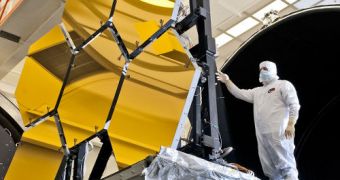Scientists managing the construction efforts for the NASA James Webb Space Telescope (JWST) announce that another important milestone has just been achieved. All the massive mirrors that will go aboard the observatory have now been covered with a special coating.
The process took place at the Moorestown, New Jersey-based Quantum Coating Inc., which is responsible for coating all 18 primary mirrors with a microscopic layer of gold particles. The reason why this chemical is used is that it boosts the infrared capabilities of the mirrors.
With the new materials, the mirrors will be able to properly reflect infrared light into the main science instruments aboard the James Webb. This marks a significant marker in the process to transform the telescope into tangible reality.
These gold particles increase the JWST's sensitivity to infrared wavelengths, allowing it to see objects that are extremely cold. For an infrared telescope, this means that difference between observing brown dwarfs, extremely cold clouds of gas and distant objects in the Universe, or not.
In addition to the 18 primary mirror segments – which together create a massive, 6.5-meter main mirror – the JWST has an additional 3 mirrors that it uses for guidance, tracking and monitoring. All of these components are made of beryllium.
This material won scientists over due to the fact that it remains tremendously stable at cryogenic temperatures of the sort the JWST will need to endure in orbit. The chemical is also very stiff and lightweight, making it an ideal candidate for Hubble's replacement.
“Finishing all mirror coatings on schedule is another major success story for the Webb telescope mirrors. These coatings easily meet their specifications, ensuring even more scientific discovery potential for the Webb telescope,” Lee Feinberg explains.
The official holds an appointment as the Optical Telescope Element manager at the NASA Goddard Space Flight Center (GSFC), in Greenbelt, Maryland. He adds that 0.12 ounces of gold were sprayed onto every mirror segment, to make beryllium more reflective to IR light.
“We faced many technical challenges on the Webb mirror coating program. One of the most daunting was that all flight hardware runs had to be executed without a single failure,” Quantum Coating director of coating Ian Stevenson explains.
After final preparations are made at Ball Aerospace, in Boulder, Colorado, the mirrors will be shipped to the X-ray and Calibration Facility at the NASA Marshall Space Flight Center (MSFC) in Huntsville, Alabama. This is where they will undergo final cryogenic testing.

 14 DAY TRIAL //
14 DAY TRIAL //